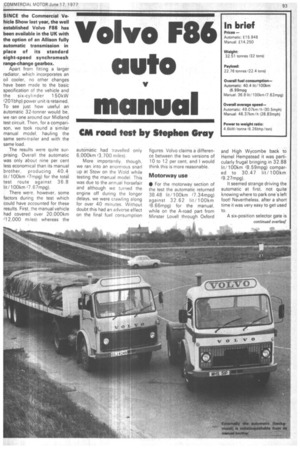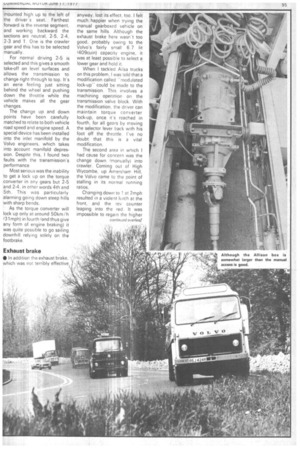Volvo F86 auto manual
Page 95

Page 97

Page 98

If you've noticed an error in this article please click here to report it so we can fix it.
CM road test by Stephen Gray
SINCE the Commercial Vehicle Show last year, the well established Volvo F86 has been available in the UK with the option of an Allison fully automatic transmission in place of its standard eight-speed synchromesh range-change gearbox.
Apart from fitting a larger radiator, which incorporates an oil cooler, no other changes have been made to the basic specification of the vehicle and the six-cylinder 150kW (201 bhp) power unit is retained. To see just how useful an automatic 32-tonner would be, we ran one around our Midland test circuit. Then; for a comparison, we took round a similar manual model, hauling the same semi-trailer and with the same load.
The results were quite surprising. Overall the automatic was only about nine per cent less economical than its manual brother, producing 40.4 lit/100km (7mpg) for the total test route against 36.8 lit /100km (7.67mpg).
There were, however, some factors during the test which could have accounted for these results. First, the manual vehicle had covered over 20,000km 112,000 miles) whereas the automatic had travelled only 6,000km 13,700 miles).
More importantly. though, we ran into an enormous snarl up at Stow on the Weld while testing the manual model. This was due to the annual horsefair and although we turned the engine off during the longer delays, we were crawling along for over 40 minutes. Without doubt this had an adverse effect on the final fuel consumption,
figures Volvo claims a difference between the two versions of 10 to 12 per cent, and I would think this is more reasonable.
Motorway use • For the motorway section of the test the automatic returned 38.48 lit/100km (7.34mpg) against 32.62 lit/100km 18.66mpg) for the manual, while on the A-road part from
Minster Lovell through Oxford _ and High Wycombe back to Hemel Hempstead it was particularly frugal bringing in 32.88 lit/100km (8.59mpg) compared to 30.47 lit/100km
/9.27mpg).
It seemed strange driving the automatic at first, not quite knowing where to park one's left foot! Nevertheless, after a short time it was very easy to get used to.
A six-position selector gate is mounted high up to the left of the driver's seat. Farthest forward is the reverse segment, and working backward the sections are neutral, 2-5, 2-4, 2-3 and 1. One is the crawler gear and this has to be selected manually.
For normal driving 2-5 is selected and this gives a smooth take-off on level surfaces and allows the transmission to change right through to top. It's an eerie feeling just sitting behind the wheel and pushing down the throttle while the vehicle makes all the gear changes.
The change up and down points have been carefully matched to relate to both vehicle road speed and engine speed. A special device has been installed into the inlet manifold by the Volvo engineers, which takes into account manifold depres sion. Despite this, I found two faults with the transmission's performance.
Most serious was the inability to get a lock up on the torque converter in any gears but 2-5 and 2-4, in other words 4th and 5th. This was particularly alarming going down steep hills with sharp bends.
As the torque converter will lock up only at around 50km /h 131 mph) in fourth land thus give any form of engine braking) it was quite possible to go sailing downhill relying solely on the footbrake.
Exhaust brake
• In addition the exhaust brake, which was not terribly effective I , t •
anyway, lost its effect, too. I felt much happier when trying the manual gearboxed vehicle on the same hills Although the exhaust brake here wasn't too good, probably owing to the Volvo's fairly small 6 7 lit 1409cuin) capacity engine, it was at least possible to select a lower gear and hold it.
When I tackled Ailsa trucks on this problem, I was told that a modification called "modulated lock-up" could be made to the transmission. This involves a machining operation on the transmission valve block. With the modification, the driver can maintain torque converter lock-up, once it's reached in fourth, for all gears by moving the selector lever back with his foot off the throttle. I've no doubt that this is a vital modification.
The second area in which I had cause for concern was the change down (manually) into crawler. Coming out of High Wycombe, up Arnersham Hill, the Volvo came to the point of stalling in its normal running ratios.
Changing down to 1 at 2mph resulted in a violent lurch at the front, and the rev counter leaping into the red. It was impossible to regain the higher gear (which would certainly have resulted in a stall) so the vehicle had to remain over revving for the duration of the climb. For this reason it seems to me that the ratio difference is too great. By compairison the manual 86 soared up the same hill -until the traffic lights half way up baulked us.
Comparison on hills
• On the faster sections of the route, particularly the motorway part, there was little difference between the manual and automatic. One area in which they did differ was when slight gradients were encountered.
Whereas the thinking driver could anticipate a hill and adjust his gear to suit, while maintaining his speed, the automatic had to wait until the last moment before changing down. This was particularly noticeable on the long motorway gradients where seemingly everything else on the road shot past us.
On some of the more severe hills the automatic spent its time changing up and down, apparently unable to decide which gear it should be in. In fairness, though, no effort was required by the driver, so it didn't become at all tiresome,.
Through towns such as Kenilworth the automatic really came into its own. The driver could concentrate on manoeuvring the vehicle, leaving • the gearbox to look after itself. No doubt this is where the automatic will really score for those operators involved in urban delivery work through towns such as Birmingham and Manchester.
Some care was needed_ though to keep the vehicle's speed down to a reasonable level. Acceleration was so effortless and unnoticed that we were often going faster than it seemed. This was particularly true when approaching roundabouts where a quick look showed the speed to be 30 not 20m ph.
The Crane Fruehauf trailer which we used for both tests was fitted with a close-coupled bogie and the whole rig Kin both cases) was up to its maximum gvw of 32 tons.
Nothing has been changed inside the cab of the F86, except that the earlier manual model had rubber matting over the engine cover while the automatic came equipped with a carpeted cover.
Despite this the interior noise of both was much the same. It was possible to hold a normal conversation in either vehicle even when travelling at speed.
As the two vehicles were equipped with exactly the same type of braking system, we didn't need to try comparative stops. The automatic pulled the vehicle up easily during our tests at MIRA without any sign of deviation, and with no effort.
Acceleration figures were very similar, too, surprisingly enough. There was, in fact, only half seconds in most of them, with the automatic being slightly slower overall.
Maintenance
• The easy to tilt F86 cab is common to both manual and automatic versions. Neither vehicles need any disconnections of the gear linkage to effect the tilt. Once fully tilted all engine components can be reached without difficulty.
Although its slightly larger than its manual counterpart, the Allison transmission still has plenty of room round it for maintenance although the only routine job is to check the transmission oil.
Overall impressions
• For those operators engaged on urban delivery work to large retail outlets where a certain amount of trunking is involved, the automatic version could well appeal.
However, for my money 1'1,700 is too much extra to pay for the convenience of automatic transmission, when a good, experienced driver can bring in better fuel consumption and probably do the job quicker.
Nevertheless, there is a saving to be made on clutches ,and transmissions by specifying the automatic. The basic once of the Volvo auto as tested is £15,946 while the manual costs £14,250.












































































































































































